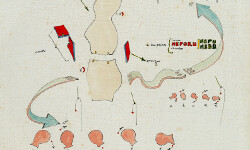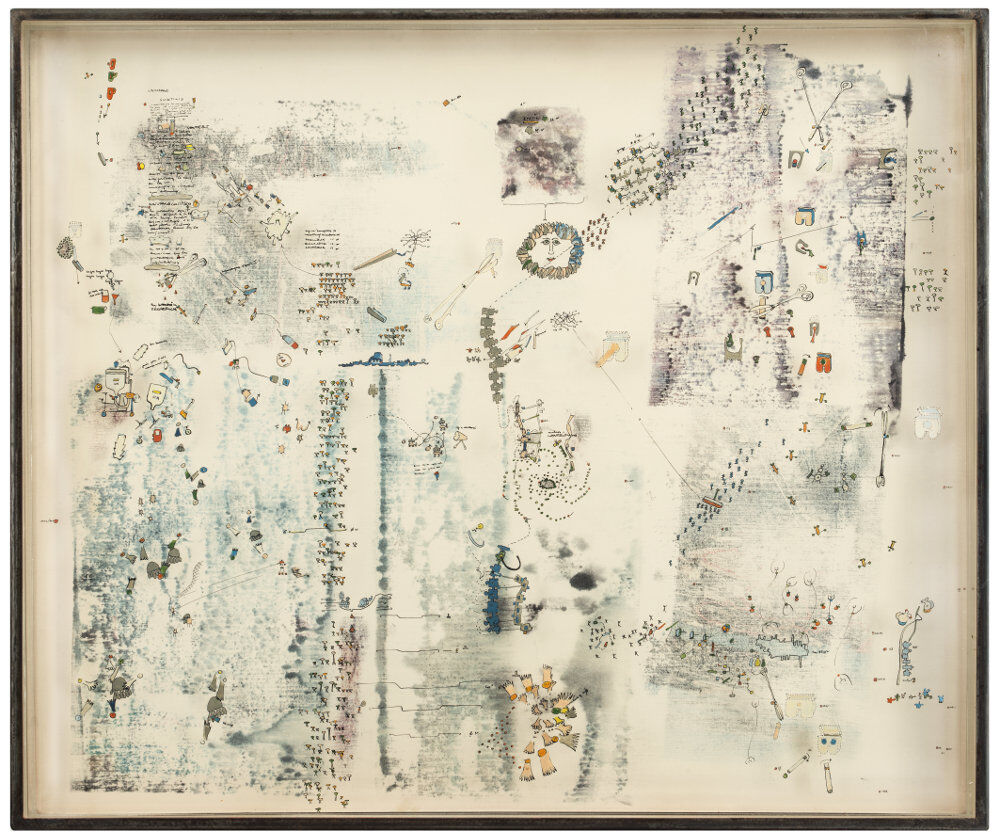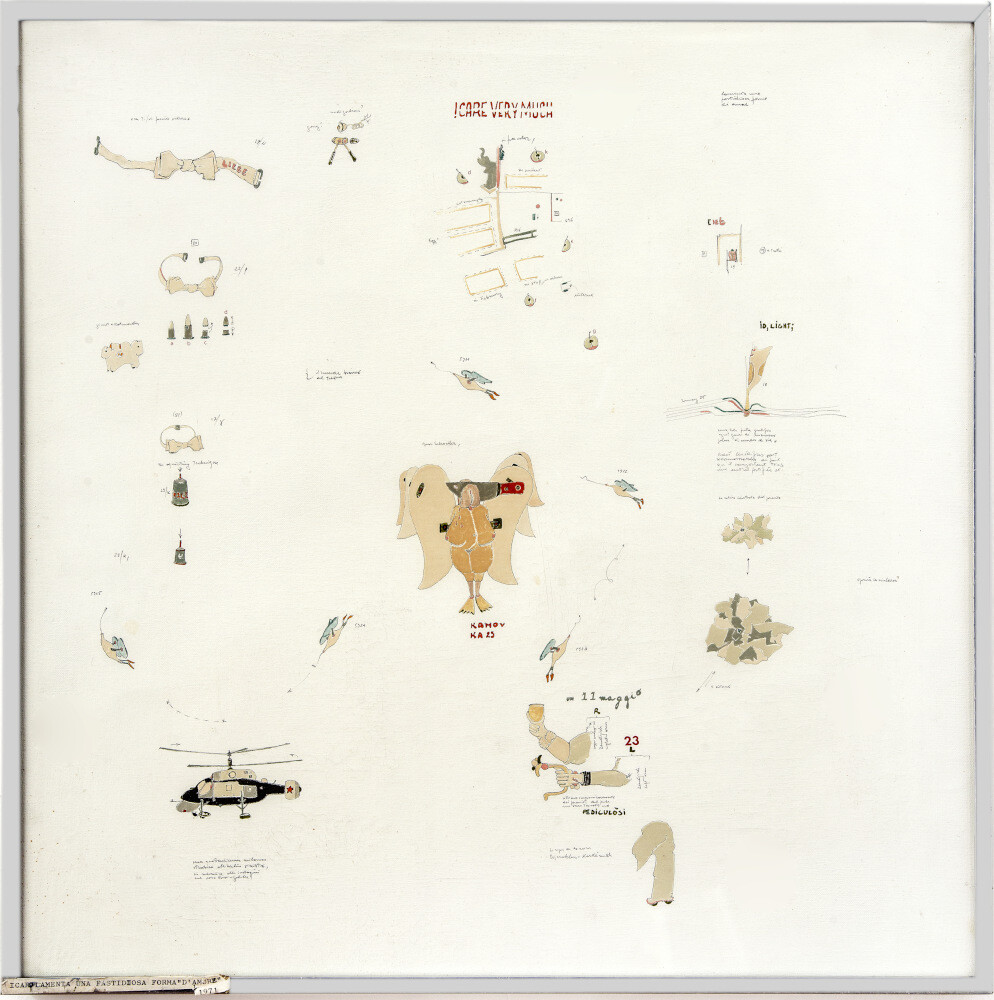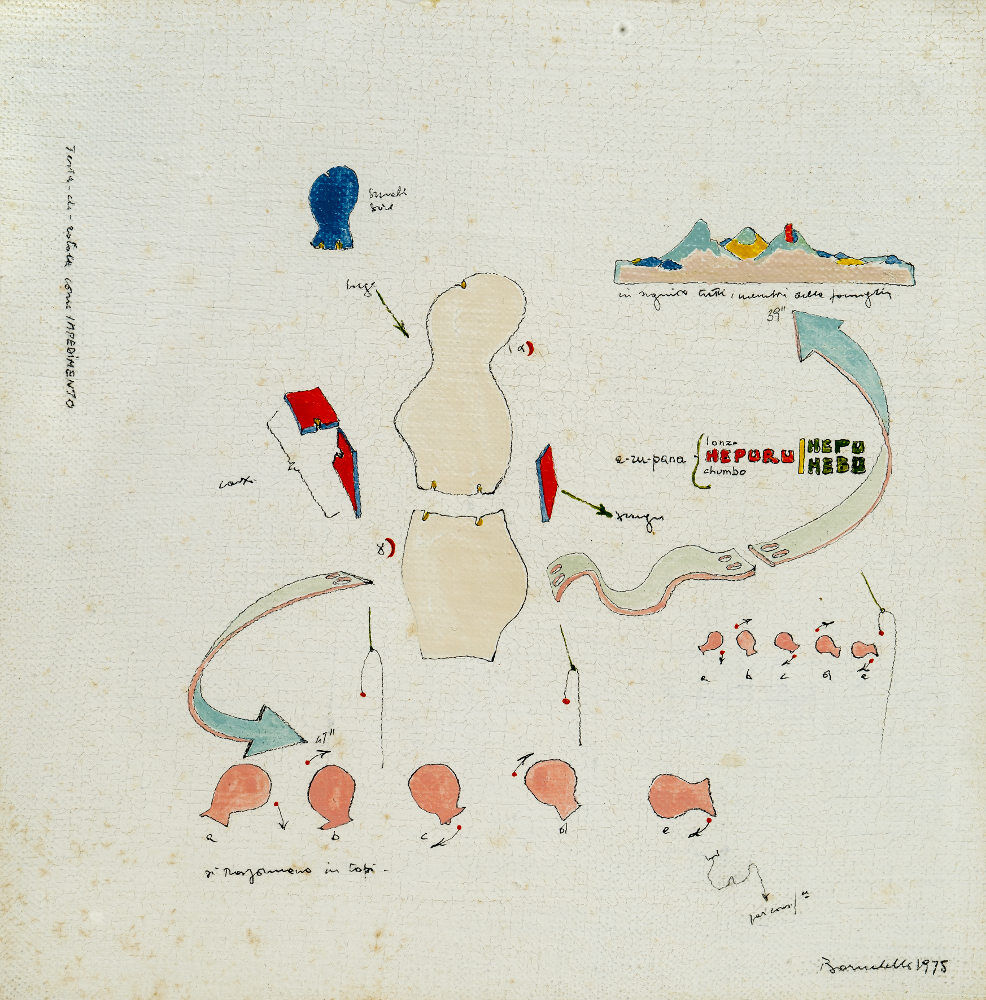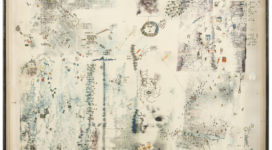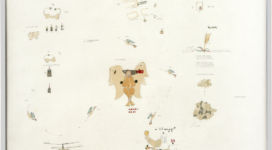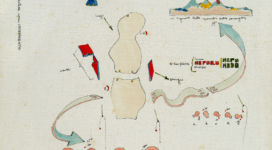| GIANFRANCO BARUCHELLO | Exhibition 2013 | |
| Catalog |
Gianfranco Baruchello was born in Livorno in 1924. After studying for a law degree in Rome and his decade-long involvement in Società Biomedica, a chemical-biological research and production company that he set up, in 1959 he turned all his attention to art. The beginnings of his research were marked by the paintings Altre Tracce (Other Traces – white canvases crisscrossed by a tangle of black lines) and a series of assemblages of found objects (amongst which Cimiteri d’opinione, Cemeteries of Opinion, 1962), in line with the school of Nouveau Réalisme.
In 1962 he started to paint large canvases, in which he was already developing his first universe of images (Entità ostile, Energia errore, Quando percettivo – Hostile Entity, Energy Error, When Perceptive – etc.): in general white surfaces, crossed by just a few marks or uncertain forms, by signs – lines, words – blotted with red lead.
Fascinated by French culture (he did not miss out on the exhibitions of Burri and Twombly staged at the time), he met Sebastian Matta and Alain Jouffroy in Paris, he befriended Marcel Duchamp in 1962, and two years later got to know John Cage in New York. Again in 1962 he took part in the group exhibition New Realists organised by Pierre Restany at the Sidney Janis Gallery in New York. Baruchello came into contact with pop art and American abstract expressionism, but his frequenting of and attention towards the international avant-garde movements had little effect on his research, as he proved independent right from the start. In 1963, the year of his first film, Il grado zero del paesaggio (Degree Zero of the Landscape) he accomplished his first solo at Galleria La Tartaruga in Rome, presented by Jouffroy: it was at this point that his miniaturised painting on large white surfaces emerged, comprising signs, letters and drawings with references to symbols of consumer and television society. He met Mario Schifano, started to work with the Schwarz gallery in Milan and in 1964 held his first solo at the Cordier & Ekstrom gallery in New York. This was the period of his first Plexiglas works, consisting of two layers of Plexiglas over bases of cardboard and the first openable wooden objects painted and drawn on the inside.
He started to work on Verifica incerta (Verification Uncertain), a film produced in collaboration with Alberto Grifi: Baruchello bought an enormous quantity of cast-off film, above all 1950s American advertising footage, and made a montage by joining the film clips together with sticky tape.
Between 1965 and 1968 the artist – who continued to exhibit prolifically in Italy and abroad – also devoted himself to other artistic activities: he wrote and published Mi viene in mente (It Comes to Mind), Ed.Schwarz, 1966, La Quindicesima riga (The Fifteenth Line), Ed.Lerici, 1967, Avventure nell’armadio di plexiglass (Adventures in the Plexiglas Cupboard), Feltrinelli, 1968; made works such as Multipurpose Object (1966); and staged ‘long-distance’ happenings by using letters or delivering materials. In 1967 he started to experiment with loss of quality, namely reduction of the image using photocopies of photocopies, initially of photographs, then of stills from TV shows; he became part of the Cooperativa Cinema Indipendente, and in 1968 he founded the company Artiflex, whose slogan was ‘Artiflex mercifica tutto’ – Artiflex commodifies all. In the early 1970s he began to experiment with the electronic image; he created objects/assemblages such as the display boxes which he filled with different elements, from found objects to clippings. In 1973 he moved to the country and on the land that he bought in Via di Santa Cornelia, on the outskirts of Rome, he set up to all effects a farm, Agricola Cornelia S.p.A., whose ‘corporate purpose was to cultivate the land’. The company also started to cultivate the fallow surrounding land, prey to speculative building, and Baruchello imbued this activity with a political and artistic value. In the early 1980s, this farming led to a series of works and two books: Agricola Cornelia S.p.a. 1973-1981, catalogue of the exhibition at Carla Pellegrini’s Galleria Milano in Milan, where in addition to works in the traditional sense, Baruchello displayed materials, texts and photographs linked to the Agricola Cornelia experience, as well as How to Imagine written with Henry Martin (1983). At this time he started to work on the topics of the home and housing: models of houses and room plans started to populate his aluminium works, drawings and objects. In 1977 he presented L’altra casa (The Other House) in his one-man exhibition at Studio G7 owned by Ginevra Grigolo in Bologna: a consideration on internal space and on the ‘female space of interiors’. The book Sentito vivere (Life in Hearsay) dates from 1978 and from 1979 the Galilée publishers in Paris published his L’altra casa – with a preface by J.F. Lyotard.
This was followed by the book A Partire dal dolce (a project that he had started in Paris in 1979 on all that is sweet, ‘dolce’ or ‘doux’, a single-copy book of images and texts and a 22-hour video tape with interviews with philosophers, critics, poets and artists); then La scomparsa di Amanda Silvers (The Disappearance of Amanda Silvers, 1982) and the anthological exhibitions at Mantua (La Casa del Mantegna) and Livorno (Museo Progressivo d’Arte Contemporanea). In 1985 the artist set in motion the garden-space project by actually creating a large lawn, which he still looks after, linked to an impressive series of canvases whose theme was reflection on the garden as a place to free one’s thoughts and emotions, followed four years later by the publication of Bellissimo il giardino (Beautiful Garden). He then published Why Duchamp: An Essay on Aesthetic Impact (1985), Uomini di pane (Bread Men, 1986) and Milletitoli (One Thousand Titles, 1987). 1988 was the year of his participation in the 43rd Venice Biennale, with a personal exhibition curated by Giovanni Carandente. The following year he took part in the exhibition Artisti Italiani contro l’Apartheid (Italian Artists Against Apartheid) and in 1990 he published Se tanto mi dà tanto (If That’s the Case). In the same year he took part in the collective Chiasmus at Bornholt Gallery in London with Pistoletto, Paolini and Catalano; and again at the Venice Biennale and the Rome Quadriennale (Roma anni ’60. Al di là della pittura, 1960s Rome. Beyond Painting, curated by Maurizio Calvesi). In 1992 he held a large personal exhibition in Aosta L’Altopiano dell’incerto (The Uncertain Upland) and turned his hand to regenerating the ‘wood-space’ between Veio and Sacrofano, which gave rise to a whole exhibition Le long de la route étrusque (The Length of the Etruscan Road) at the Krief gallery in Paris in 1996. In the same year he made a lot of videos and started to reflect on the numeric-digital system of the video image with comparison to painting; he wrote Quaranta sere in TV (Forty Evenings on the TV, from which forty films were then selected). In 1997 he inaugurated his new studio-atelier in Viterbo, with projections on the topic of the studio, garden (Giardino) and wood (Bosco). In 1998, together with Carla Subrizi, he set up the Fondazione Baruchello, located in his former home-studio and farm in Via di S. Cornelia on the Roman hills, with the intent to carry out research activities on contemporary art. In 2003 Breve storia della mia pittura (Short Story of My Painting) was published on occasion of the one-man show at Galleria Peccolo in Livorno, followed by Sulla necessità di fare arte oggi (On the Necessity to Make Art Today, 2004), in addition to ongoing solo and collective exhibitions in Italy and Europe: Galerie Meert Rihoux, Brussels (2004); Galleria Civica, Pop Art Italia 1958-1968, Modena; Galerie Hasenclever, Munich (2005); MACRO, La Collezione: opere scelte (The Collection: Selected Works), Rome (2006); Moderna Museet, Time & Place: Milano – Torino, Stockholm (2008); Galerie Michael Janssen, Berlin (2009). Between the end of 2011 and the beginning of 2012, the Galleria Nazionale d’Arte Moderna in Rome presented the anthological exhibition Certe idee (Certain Ideas) curated by Achille Bonito Oliva. He was invited to the Kassel dOCUMENTa. Dating from 2013 is the Vice versa exhibition project for the Italian pavilion, curated by Bartolomeo Pietromarchi, at the 55th Venice Biennale, promoted by the Ministry for Cultural Heritage and Activities through the Directorate-General for the Landscape, Fine Arts, Architecture and Contemporary Art, in the exhibition by Massimiliano Gioni on the Palazzo Enciclopedico (The Encyclopaedic Palace).
Works by the artist are in important museums and film and video collections all around the world.
